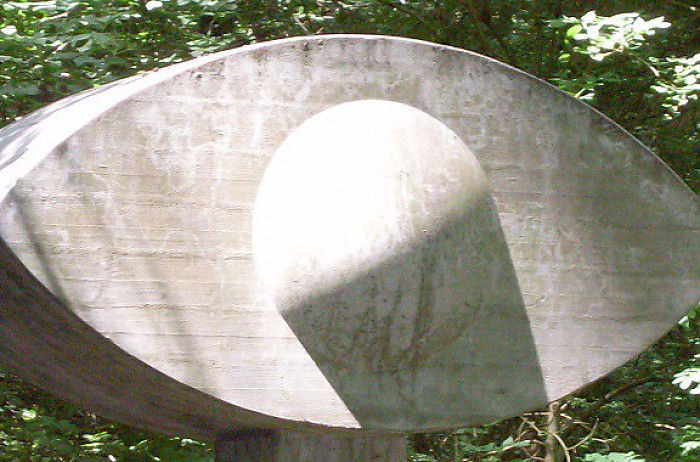

About the Artist Necropolis
The Artists' Necropolis at the Blue Lake in Kassel was Harry Kramer's last major art project. Up to 40 artists are supposed to build their tombs here during lifetime. The discussions with authorities and environmental activists lasted over a decade until 1992, when this utopia finally became reality.
For Harry Kramer, his uneasiness about art in public space was the decisive reason to realize his ideas of his artist's cemetery in the recreational area of the Habichtswald near Kassel. Around 1980, he accused urban planning of instrumentalizing art in order to conceal social interventions in urban structures. He argued that the symbolic function subordinated to the works of art was used to direct the displeasure about urban planning interventions at the works of art. In Kramer's view, the only field in which art finds its own unmistakable identity was that of the cult of the dead. Here, the artist does not have to search for superficial content, since the purpose of the work of art imposes itself upon the artist.
Something would have been missed if criticism of the funeral system had not been adressed in the context of this project. Harry Kramer's much quoted question, whether it would not be more appropriate to feed the carcasses to buzzards and dogs instead of leaving them to the mortician to be put aside, was therefore almost obligatory. But the actual intention of enforcing the necropolis was, apart from critically questioning the funeral conventions, to offer the selected artists an opportunity to create authentic works again, free of all constraints and obligations.
In September 1992 the tombs of Rune Mields and Timm Ulrichs were the first monuments to be erected. Works by Fritz Schwegler, Werner Ruhnau, Heinrich Brummack, Blalla W. Hallmann, Karl Oskar Blase, Ugo Dossi and Gunter Demnig followed.
As in the funeral forests, which established themselves in Germany 10 years after the inauguration of the Artists' Necropolis, only ash urns may be buried in the necropolis. Indirectly, the necropolis also radiates into the tomb area. Through it, the tomb itself has regained its importance for art, which it lost in the 19th century at the latest.
A New Tombstone 2021
Press release for the inauguration of the clay dome by Gernot Minke
Gernot Minke's gravesite in the artists' necropolis
It is a special gravesite with which the architect and painter Gernot Minke joins the list of monuments by Rune Mields, Timm Ulrichs, Fritz Schwegler, Werner Runau, Heinrich Brummack, Blalla W. Hallmann, Karl Oskar Blase, Ugo Dossi and Gunter Demnig.
For in German-speaking countries, the deceased are traditionally commemorated with grave monuments rather than with buildings. Grave buildings such as crypt buildings or mausoleums are rather rare in Germany. They are among the rarities in the German cemetery landscape. I am therefore all the more pleased that today we are inaugurating Gernot Minke's walk-in sculpture, a purely architecturally conceived work of art. With his dome, he takes up a tradition in dealing with the commemoration of the dead, which in other European countries has given rise to impressive funerary architecture up to the present day, but which in Germany – with a few exceptions – was abandoned in the first half of the 20th century.
Gernot Minke was born in Rostock in 1937. From 1957 to 1964 he studied architecture in Hanover and Berlin. He then worked until 1968 as a research assistant to Frei Otto, whose wide-span load-bearing structures and tent buildings caused a sensation at the time and whose experimental approach to form-finding was to shape Gernot Minke.
During his time as a professor at the University of Kassel, Minke founded the Research Laboratory for Experimental Building and realized more than 40 projects worldwide in low-cost housing and ecologically sustainable construction using earth-bound building techniques. With more than 50 different vault and dome structures made of earth, he advanced to become a recognized earth building expert far beyond Europe.
In view of these successes as a representative of sustainable building, painting was usually overlooked as another of Gernot Minke's areas of artistic creativity. But at the latest in connection with his earthen buildings for documenta 14 "Earth – Space – Sound 1 and 2", Gernot Minke presented himself to an international audience with his meditation paintings not only as an architect, but also as a painter.
The tomb, which was inaugurated in the necropolis on November 4, 2021, is a consistent further development of the domed building and tower that Minke had designed for documenta 14. This is the first time that purpose-free architecture has been created at the Blue Lake, i.e., a structure whose architecture is stripped of all functionality. The dome lacks any superficial purposefulness. It is not meant to house or protect anyone, it is not conceived as an event space or as accommodation, although it could be used accordingly.
The atmosphere of the structure and the experience of the space are thus not shaped by functionality, but emerge and change with the people who enter it, how they engage with the space, its temperature, acoustics, and texture, how they express that experience, or how they use the space.
The circular, quarry-stone entrance prompts visitors to bow as they enter the space. As they rise, a large opaion at the apex of the dome provides a view of the sky. The basalt floor, which slopes down toward the center, connects those present to the earth. The rounded shapes of the bricks made of rammed earth contribute significantly to the special acoustics of the room. In their layering, they are reminiscent of tholoi, Copper and Bronze Age domed tombs with their cantilevered vaults of quarry stones that were common throughout the Mediterranean.
The materials clay, straw and stone support the architectural concept, which in its archaic appearance refers to something supra-temporal and thus opens up the possibility of seeing oneself as part of something larger. These are materials that were not only used for the earliest cultural products, but also appear in creation myths. As materials, they were created through decay and decay. As sediments, they formed the basic substance here, from which new things were created and which, under favorable circumstances, will survive for a long time before disappearing themselves at some point.
With the dome, Gernot Minke has created a place of contemplation which, with its 24 seats, invites visitors to linger for a longer period of time, whether for communal meditation, singing or exchanging ideas. As a walk-in sculpture that can be entered by anyone, Gernot Minke's work of art was intended from the outset to be participatory. At the same time, the dome construction has created a protected space in a publicly accessible location that, as a gravesite, encourages one to come to terms with one's own finiteness or to deal with what one has lost or will lose at some point.
Gerold Eppler
First time a monument 2021
Press release on the inauguration of the monument for Manfred Schneckenburger
Monument to Manfred Schneckenburger inaugurated in the artists' necropolis
Tribute to Manfred Schneckenburger, who died in December 2019 in Cologne: today, Friday, June 18, 2021, a monument to the two-time documenta director was inaugurated in the Artists' Necropolis. It was designed by the artist Ugo Dossi.
Manfred Schneckenburger was connected with the Necropolis in many ways. As early as April 25, 1985, he took part in the founding meeting of the Artist Necropolis support association. Until the realization of Harry Kramer's utopia of a burial place for artists – because a cemetery like the Nekropole was unthinkable in Germany for formal legal reasons until October 1, 1992 - Manfred Schneckenburger supported his friend Harry Kramer on his way through the instances. With the establishment of the Artist Necropolis Foundation in 1992, Manfred Schneckenburger became a member of the foundation's board.
"Prof. Dr. Manfred Schneckenburger was instrumental in supporting the idea of the Artists' Necropolis from its inception until his death in 2019 and promoted its implementation. I am pleased that his services to this unique place in the Habichtswald are now honored in a special way and at this place with this monument, which Schneckenburger's long-time friend Ugo Dossi created," said Head of Cultural Affairs Dr. Susanne Völker at the inauguration in the presence of the artist Ugo Dossi, the Chairman of the Board of Trustees Gerold Eppler, other members of the Board of Trustees and local chief Reinhard Wintersperger.
For Manfred Schneckenburger, the artists' necropolis reflected Harry Kramer's concept of art and his idea of artistic autonomy to the last degree. With the Necropolis, Kramer wanted to create the possibility for artists to realize their ideas of art free of any restrictions and away from the museums; in the middle of the forest, at the place where they would eventually be buried. Manfred Schneckenburger felt committed to this idea.
Accordingly, together with the Board of Trustees, he further developed the art project at Blauer See after Kramer's death. For the Board of Trustees, which reconstituted itself in 2020, it was therefore clear that these merits must find visible expression in the necropolis. It thus unanimously decided to permanently honor Manfred Schneckenburger with a monument here on site.
A sculpture by Ugo Dossi will from now on keep alive the memory of the extraordinary exhibition organizer and university professor next to the gravestones of Schneckenburger's deceased artist friends Karl-Oskar Blase and Heinrich Brummack. Ugo Dossi, himself a two-time documenta and biennial participant, was a close friend of Manfred Schneckenburger.
Ugo Dossi's works, which often move in the area of tension between science and art, nevertheless subtly sound out border areas: Be it that they are dedicated to paranormal phenomena, be it that they make the unconscious sensually tangible or the invisible visible.
Dossi's monument to his long-time friend also oscillates between the material and the immaterial. Immovably made of light granite, a chalice towers over the one-meter-high pedestal with the inscription of the deceased's name. Looking at the sculpture, the profile of Manfred Schneckenburger appears in its outline. As a conundrum, Ugo Dossi's work of art thus depicts the gap that Manfred Schneckenburger's death has left in the art world. At the same time, the sitter is visible through the profile and, despite his physical absence, is always present in the necropolis.
City of Kassel
We offer guided tours to the artists' necropolis for children, schools, professionals or those who like to wander! On the respective pages under "Education & Mediation" you will find further information.
Bookings
Ines Niedermeyer
Position: Secretariat
Telefon: 0561 918 93 40
Questions and Information
Gerold Eppler M.A.
Position: Deputy Director, Museum Education
Telefon: 0561 / 918 93 23
Harry Kramer
25. January 1925 – 20. February 1997
(Anonymus grave)
As an artist, Harry Kramer cannot be assigned to a style or genre. The dancer, painter, sculptor and filmmaker had his breakthrough in 1964 with his "Mechanical Theater" at documenta 3, where Arnold Bode showed Harry Kramer's kinetic sculptures in the "Light and Movement" section along with works by Jean Tinguely, Nicolas Schöffer and Jesús Rafael Soto.
As the founder of the artists' necropolis in Kassel, Harry Kramer dealt with death in many ways. For example, in his film "The Lock", in his "Breadheads" or in his writing panels on the Apocalypse.
In 1997 Harry Kramer was buried anonymously in the necropolis.
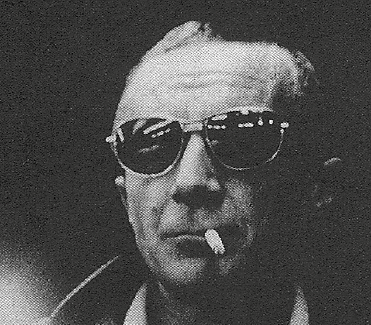
E. R. Nele
*17. March 1932
The Walk (2022)
On June 21, 2022 the tombstone "The Walk" was inaugurated. The sculptor is E. R. Nele, daughter of the documenta founder Arnold Bode and participant of the documenta exhibitions 2 and 3. Looking at her diverse oeuvre, one realizes that the human being as such is at the center of her artistic work. And that with everything he experiences as a social being: Pleasure and joy of life, solidarity and isolation, suffering and annihilation. Emotions and inner attitudes that spring from these experiences become visible in the sculptures, reduced to the essential basic forms of the body, through gestures, postures, ponderations and arrangements of the human body. The human figure, mostly strongly abstracted and usually filigree formed, transports the artistic idea.
"The Walk" is placed in a hollow way leading down to the shore of the Blue Lake. On a steel tube that connects two pillar-like houses that are bent in on themselves, a human figure carefully places one leg in front of the other. In her hands she holds a light balancing pole. The thin limbs and the mesh of stainless steel bands make the figure appear fragile. What is disconcerting is the shape of the pillars. Their curvature makes them seem to sway. This makes crossing them seem dangerous and arriving on the other side a dare.
"The Walk" shows a balancing act similar to that of a tightrope walk, a border crossing between heaven and earth, between future and past. Concentration, body control, but above all keeping one's balance are the factors that can prevent the crash and fall into nothingness.
The acrobat in the necropolis thus becomes not only a symbol of the "dance over the abyss," but also a metaphor of transition and the journey beyond. In this way, "The Walk" provides the impetus to reflect on how we position ourselves in relation to our finitude and what awaits us after death.
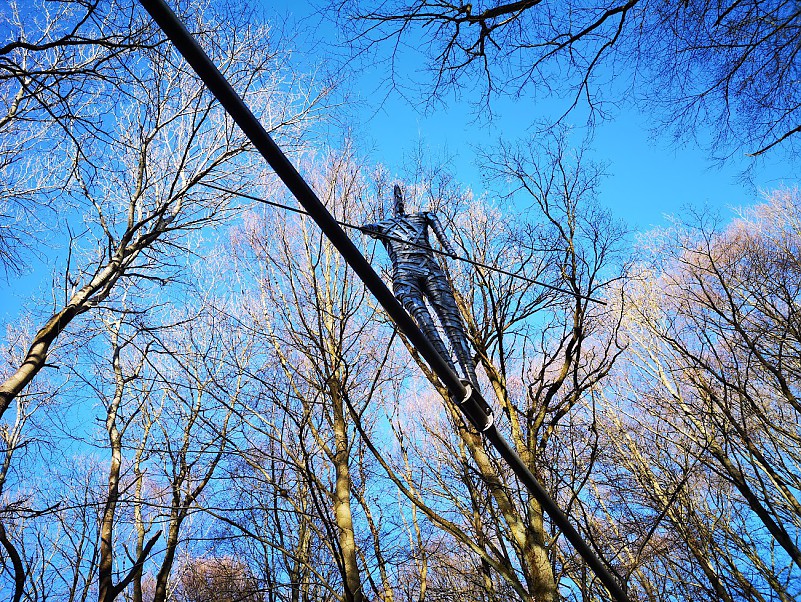
© Museum für Sepulkralkultur, Kassel, Bildarchiv
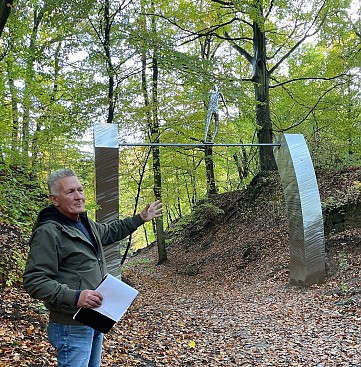
© Museum für Sepulkralkultur, Kassel, Bildarchiv
Gernot Minke
* 8. April 1937
Clay Dome (Lehmkuppel) (2021)
The tomb is a consistent further development of the dome and tower that Gernot Minke had conceived for documenta 14. The dome lacks any superficial purposefulness. It is not intended to house or protect anyone; it is not conceived as an event space or as accommodation, although it could be used accordingly.
The circular entrance causes visitors* to bow as they enter the space. As they rise, a large opening (opaion) at the apex of the dome provides a view of the sky. The basalt floor, which descends toward the center, connects those present to the earth. The rounded shapes of the bricks made of rammed earth contribute significantly to the special acoustics of the room. In their layering, they are reminiscent of tholoi, Copper and Bronze Age domed tombs with their cantilevered vaults of quarry stones that were common throughout the Mediterranean.
The materials clay, straw and stone support the architectural concept, which in its archaic appearance refers to something supra-temporal and thus opens up the possibility of seeing oneself as part of something greater.
With the dome, Gernot Minke has created a place of contemplation that, with its 24 seats, invites one to linger longer, whether for communal meditation, singing or gathering.
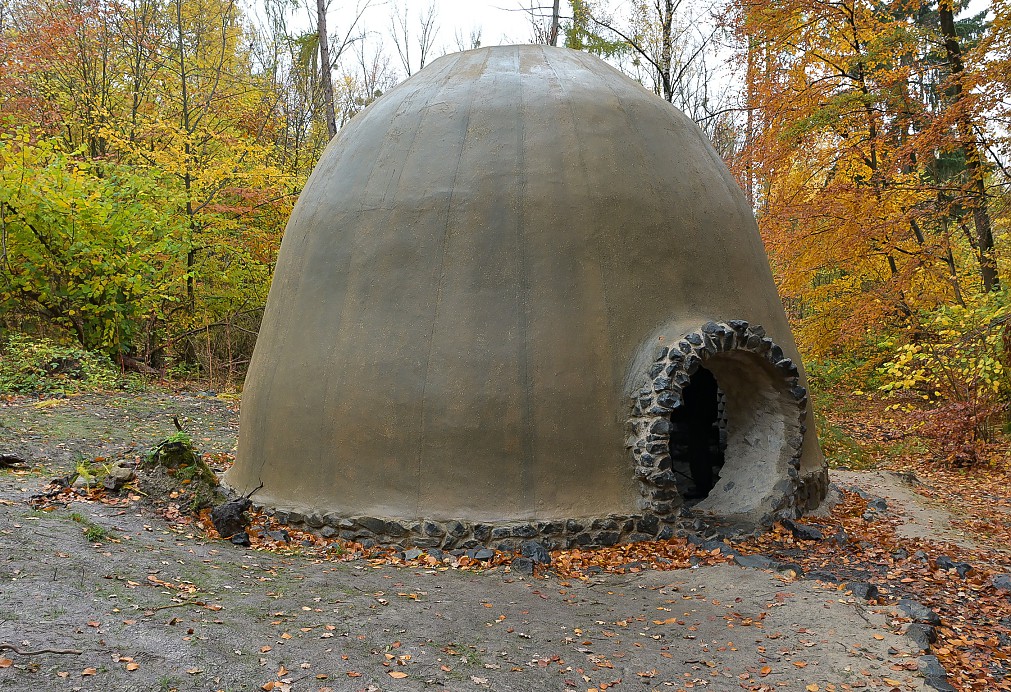
Photo: Harry Soremski
© Stadt Kassel
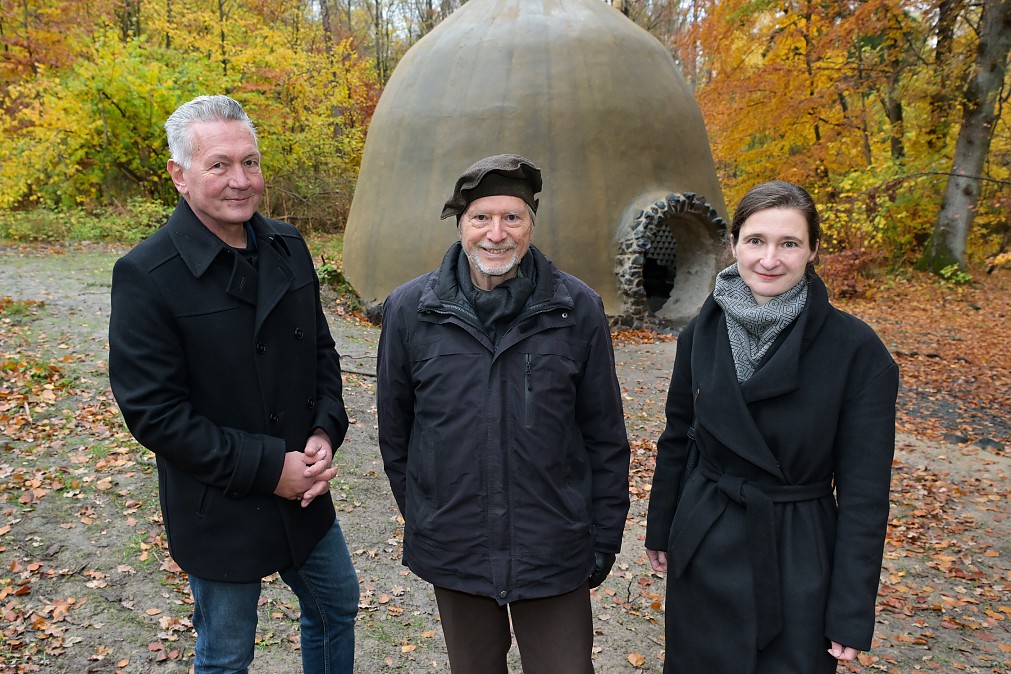
Photo: Harry Soremski
© Stadt Kassel
Manfred Schneckenburger
1. December 1938 – 3. December 2019
Monument to Manfred Schneckenburger (2021)
designed by Ugo Dossi
On December 3, 2019, Manfred Schneckenburger died two days after his 81st birthday in Cologne. On June 18, 2021, a monument to the two-time documenta director was inaugurated in the necropolis at the Blue Lake.
Manfred Schneckenburger was connected to the Necropolis in many ways. Already on April 25, 1985, he participated in the founding meeting of the Artist Necropolis support association. Until the realization of Harry Kramer's utopia of a burial place for artists, Manfred Schneckenburger supported his friend Harry Kramer on his way through the instances and became a member of the foundation board with the establishment of the foundation Artist Necropolis.
Ugo Dossi's monument to his long-time friend will keep the memory of the exhibition organizer and university professor alive. It oscillates between the material and the immaterial. Immovable, made of light granite, a chalice towers over the one-meter-high pedestal with the inscription of the name of the deceased. Looking at the sculpture, the profile of Manfred Schneckenburger appears in its outline. As a conundrum, Ugo Dossi's work of art thus depicts the gap that Manfred Schneckenburger's death has left in the art world. At the same time, through his profile, the sitter is visible and present despite his physical absence.
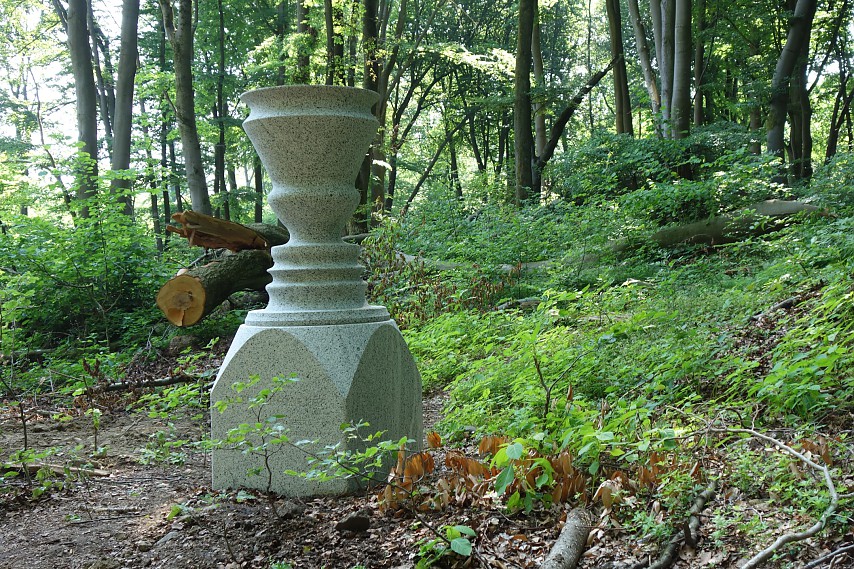
Photo: Harry Soremski
© Stadt Kassel
Gunter Demnig
*27. Oktober 1947
Circuitus (2011)
Gunter Demnig became known for his "Stolpersteine", which he has been laying in front of the houses of people murdered during the Nazi regime since 1997. In view of the controversies surrounding his art actions in public space, in which artistic and political social fields of action often overlap, Demnig's sculptural works usually take a back seat. The bizarrely intertwined sound installations, which dissolve the boundaries between music and sculpture, are as little known as the "Hydraulic Sculptures".
These are constructed according to the principle of water clocks. They are among the oldest forms of time measurement and were used in ancient times to water the fields. Because the hydraulic sculptures combine statics and movement as well as duration and change as seemingly conflicting principles, they are also suitable as analogies for the cycle of becoming and passing away. And so it was obvious that it is precisely this group of works that forms the starting point for Gunter Demnig's tomb "Ciruitus".
As long as Gunter Demnig lives, the inner cylinder rises high up. After Demnig's death, his urn will disappear in the sculpture and the cylinder will sink down.
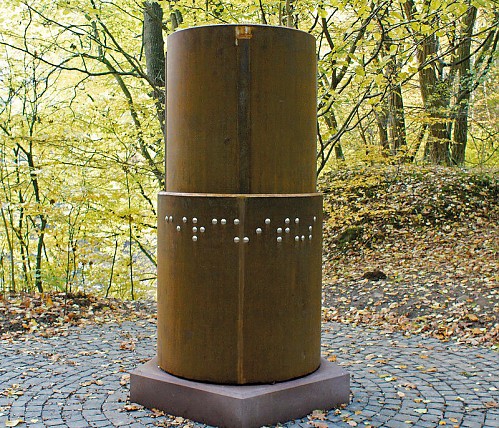
Photo: Gert Hausmann
© Stadt Kassel
Ugo Dossi
*1. November 1943
Denk-Ort (2003) (Think Tank)
Various pictograms were cut into the eight steel plates using laser technology. Four different faces of death appear in the inner square. On the plates of the outer square, forms of the soul are represented. Ugo Dossi's artistic concern is to make the invisible visible. His approach connects him with scientists. Through the method of automatic drawing he tries to open up the visual language of the unconscious. The pictograms developed out of this context are symbols of collective longings, desires and fears and thus also of feelings that death can trigger in people's imagination.
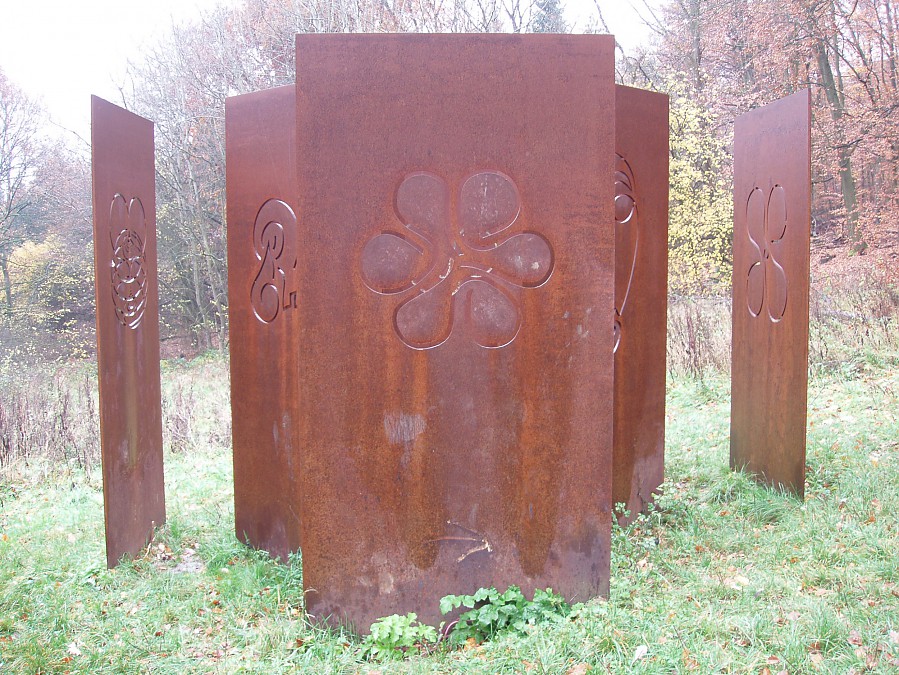
© Museum für Sepulkralkultur, Kassel, Bildarchiv / VG Bild-Kunst Bonn
Blalla W. Hallmann
23. März 1941 – 2. Juni 1997
Abendtreffen an der Lichtung – Harrys Abschied (1998) (Evening Meeting at the Clearing - Harry's Farewell)
On the occasion of the death of Harry Kramer, Blalla W. Hallmann painted this picture for Helga Kramer. She donated the painting to the necropolis in memory of Harry Kramer, whose ashes were buried anonymously at the Blue Lake.
Blalla W. Hallmann himself passed away shortly after he had made the painting for the deceased friend. He died even before he could design his own tomb for the artists' necropolis. Thus the painting has since served as an epitaph, a funeral monument without a buried body, both for himself and for Harry Kramer.
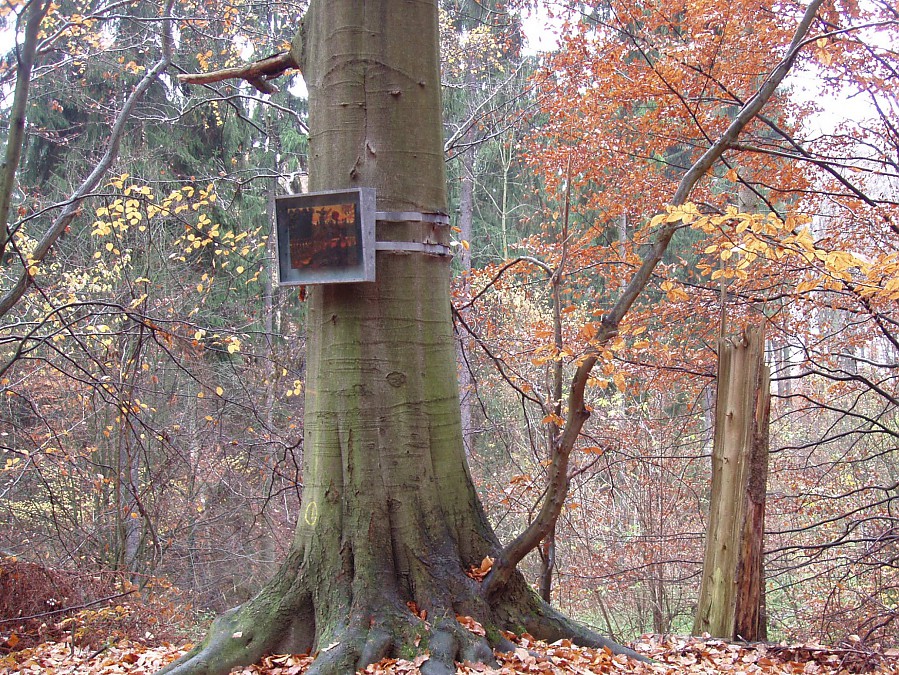
© Museum für Sepulkralkultur, Kassel, Bildarchiv / VG Bild-Kunst Bonn
Heinrich Brummack
19. January 1936 – 21. February 2018
Vogeltränke (1997) (Bird Bath)
The "Bird Bath" consists of three elements. A monumental circular disc rests on two sarcophagi. The octagon in the middle of the disk is slightly recessed so that rainwater can collect. At first glance, the motif of the bird bath seems plausible for a tomb standing in the middle of a forest. It is no coincidence that the bowl, which catches and preserves the water, settles inside the round stone disc as an octagon. The eight is the number of the happy new beginning. In Christianity, the eight therefore becomes a symbol of resurrection and new creation in baptism.
Heinrich Brummack's "Bird Bath" is thus a baptismal font and tomb at the same time. Baptism and burial, birth and death, beginning and end are brought together here and form a unity. The circle that encloses the octagon can be understood in this context as a symbol of the cosmos and as an eternal cycle of becoming and passing away.
Heinrich Brummack died in 2018. The urn in which his ashes were buried has the shape of a golden rabbit.
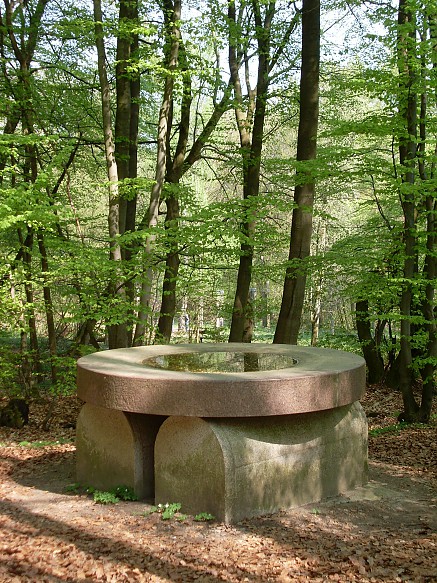
© Museum für Sepulkralkultur, Kassel, Bildarchiv / VG Bild-Kunst Bonn
Werner Ruhnau
11. April 1922 – 6. March 2015
Spielraum (1995) (Scope)
Werner Ruhnau was one of the most important theater architects of the 20th century. The Gelsenkirchener Theaterbauten (today "Musiktheater im Revier"), which were opened in 1959, still set standards in theater architecture today. Under the idea of the "Bauhütte", Werner Ruhnau conceptually included sculptors such as Robert Adams, Paul Dierkes, Norbert Kricke and Jean Tinguely as well as the painter Yves Klein in the design. The two monochrome picture panels on the outer walls of the foyer and four monochrome large-format sponge reliefs in a special ultramarine blue contributed significantly to the international recognition of the French painter and founder of "Nouveau Réalisme".
In 1995 Werner Ruhnau built his burial place in the form of an amphitheater in the artists' necropolis founded by Harry Kramer. With his tomb, the architect wants to invite visitors to play along. Eight "guard" heads were attached to the four gates in 1995 by the Mülheim artist Jochen Leyendecker. From here, four paths lead directly to the outer perimeter strips of the small amphitheater in the center of the complex.
Play and dance are also central elements at this location. Since the inauguration, Werner Ruhnau and Elisabeth Stelkens have regularly rehearsed their funeral ceremony at their future burial site in the form of a scream dance to a trumpet piece by Landgrave Moritz. This dance was also performed by family members and friends at the funeral of Werner Ruhnau on April 11, 2015.
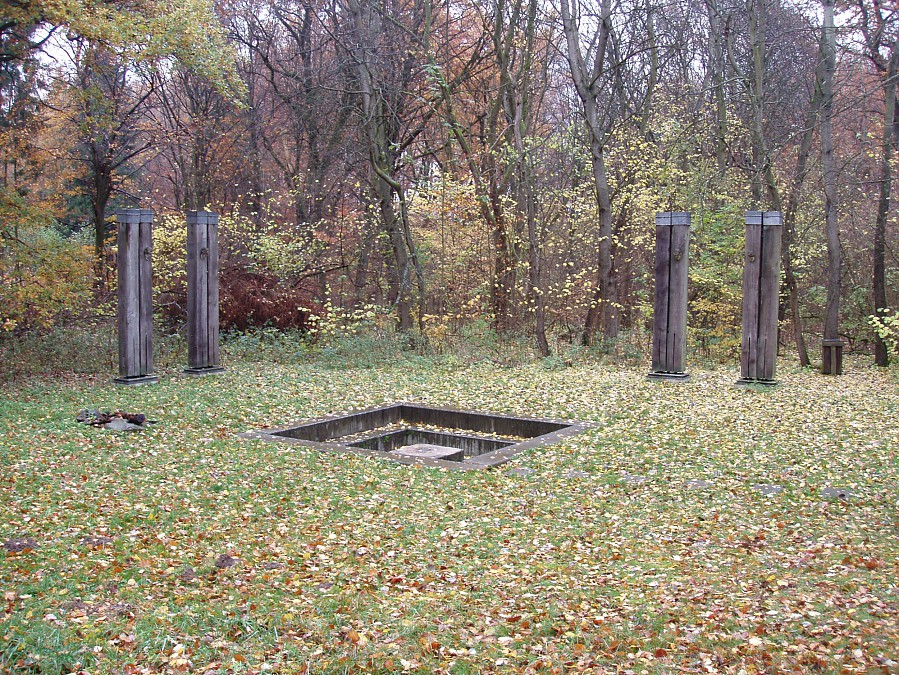
© Museum für Sepulkralkultur, Kassel, Bildarchiv / VG Bild-Kunst Bonn
Karl Oskar Blase
24. März 1925 – 27. Dezember 2016
Momentum (2001)
Karl Oskar Blase was involved as a graphic artist in several documenta exhibitions – both as a participant and as a designer of signets, signage systems and catalogs. In his tomb "Momentum" he has given duration to a moment (moment) as a monument.
An oversized eye is enthroned on a pillar with a rectangular ground plan. At the front, the lens bulges outwards, at the back it is retracted – like the gaze of the observer, who, in view of the tomb monument, may – if only for a moment – direct his gaze to his own innermost self. Since 2005, Marga Blase, the graphic designer's wife, is also buried here. Karl Oskar Blase died on December 27, 2016.
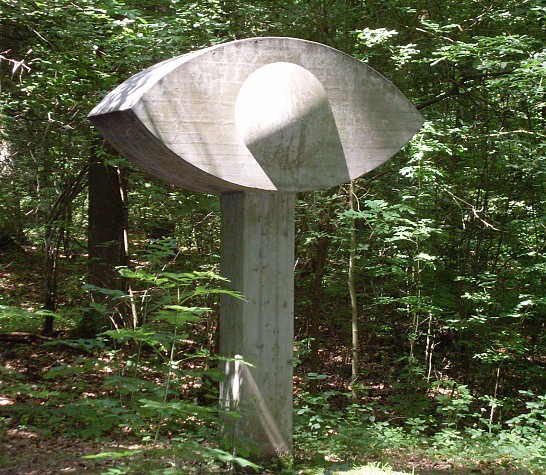
© Museum für Sepulkralkultur, Kassel, Bildarchiv / VG Bild-Kunst Bonn
Fritz Schwegler
7. May 1935 – 3. June 2014
EN 6355 (1993)
"EN 6355" is perhaps the most enigmatic grave sign in the artists' necropolis. Before the lid of the sarcophagus with two inscriptions was closed in 1993, Fritz Schwegler deposited two "Notwandlungsstücke" (emergency conversion pieces) and an "Abulvenz-Buch" in it. In his works Schwegler questioned the concept of things. His picture collages, small sculptures and puns seem familiar at first glance. But they always deviate from the everyday through changes and variations and thus challenge the viewer to reflect.
Fritz Schwegler provided all his ideas and works with "ENs", so-called "publication numbers". This is also true for the inscriptions "WEISZt DU WEIL ICH BIN UND DU BIST AUCH HIER" (EN 4826) and "LEBENSMÜDE? - ABULVENZ!" (EN 6036). These are called "effeschiades" as a derivation of the artist's initials - "Eff" for "Fritz" and "Esch" for "Schwegler".
The artist's ash urn was also supposed to be buried in the sarcophagus, but things were to turn out differently. In 2014 Fritz Schwegler was buried at the village cemetery in Breech.
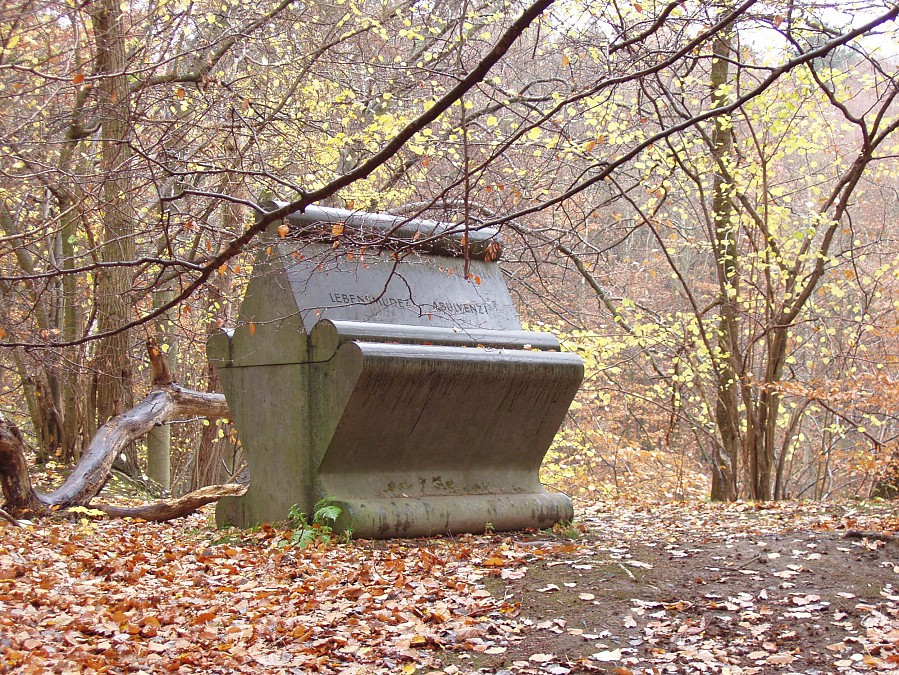
© Museum für Sepulkralkultur, Kassel, Bildarchiv / VG Bild-Kunst Bonn
Timm Ulrichs
*31. March 1940
Timm Ulrichs auf der Unterseite der Erdoberfläche (1992) (Timm Ulrichs on the underside of earth's surface)
Timm Ulrichs works as a conceptual artist both multimedia and performative. As a self-proclaimed "total artist" he spectacularly displayed his personal awareness of finiteness. In 1977 he walked through a thunderstorm with a copper bar on his back. In 1981 he let himself be locked up in a hollowed out erratic block for 10 hours, and since 1981 the tattoo "THE END" his written on his right eyelid.
In 1992 a bronze body cast of the artist was buried upside down on the edge of the Blue Lake. The view of the visitor falls through the soles of his feet into the inside of the figure. The bronze shell of the tomb thus encloses the space that the artist occupied when his body was poured off. After the artist's death, the sculpture will absorb his ashes.
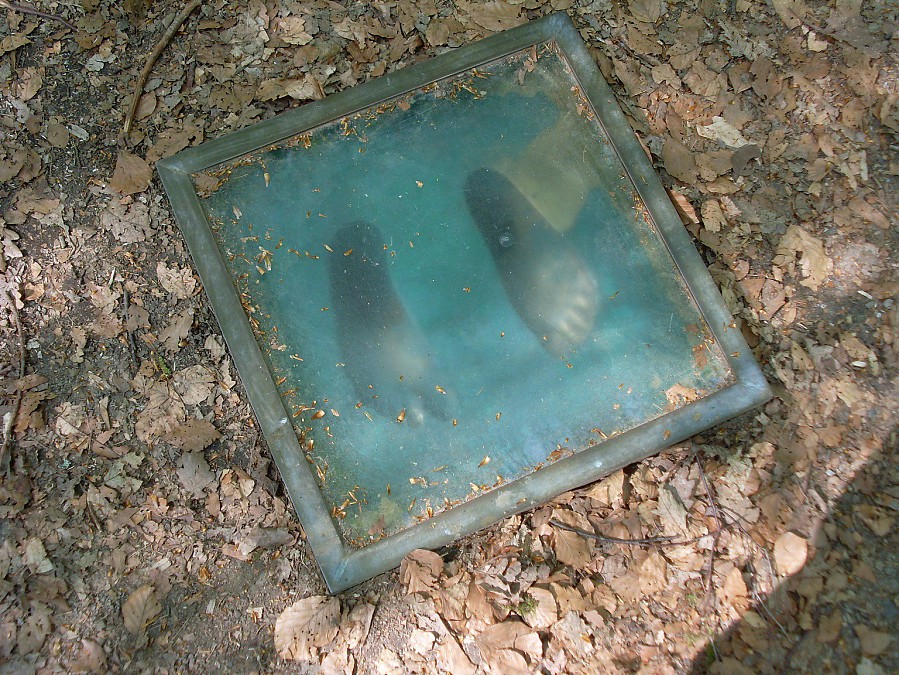
© Museum für Sepulkralkultur, Kassel, Bildarchiv / VG Bild-Kunst Bonn
Rune Mields
*1935
La vita corre come rivo fluente (1992)
The tomb of Rune Mields consists of a row of white and black cubes. After each black stone the band changes its direction. It meanders through the meadow like a stream in a plain. Each black cube has a letter carved into it. The sequence of letters gives the title of the tomb "La vita corre, come rivo fluente". Since each black stone takes the place of a prime number, there are different distances.
Again and again, mathematical phenomena formed the starting point for artistic projects at Rune Mields. When transferring rational knowledge into artistic manifestations, an indecipherable residue always remains perceptible in her works.
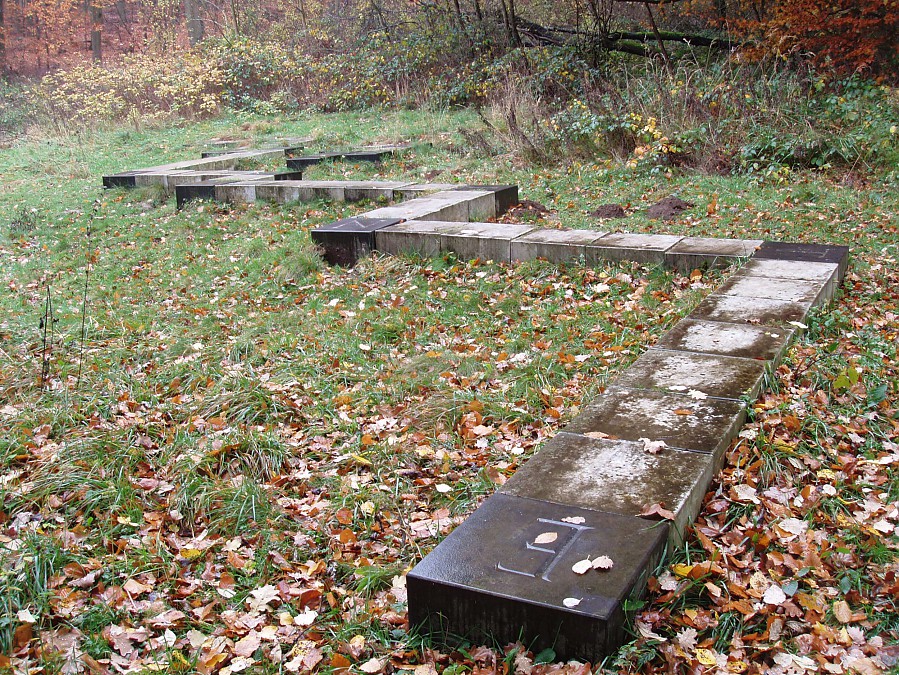
© Museum für Sepulkralkultur, Kassel, Bildarchiv / VG Bild-Kunst Bonn
Arbeitsgemeinschaft Friedhof und Denkmal e.V.
Zentralinstitut für Sepulkralkultur
Museum für Sepulkralkultur
Weinbergstraße 25–27
D-34117 Kassel | Germany
Tel. +49 (0)561 918 93-0
info@sepulkralmuseum.de








